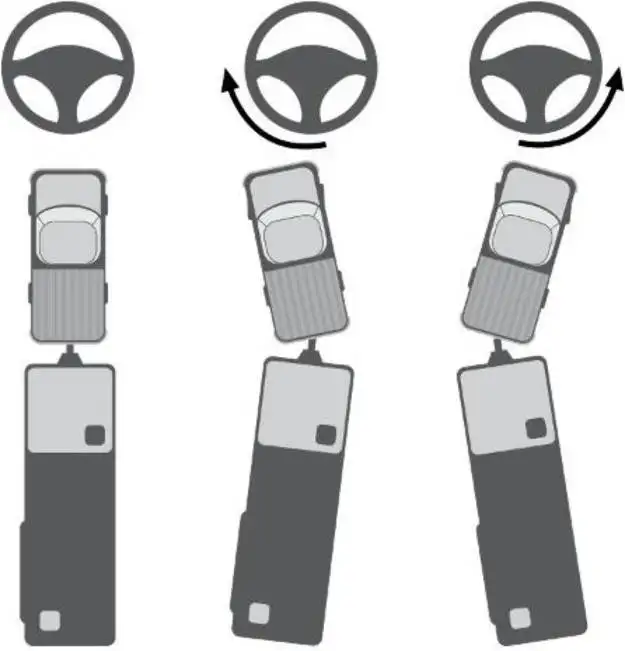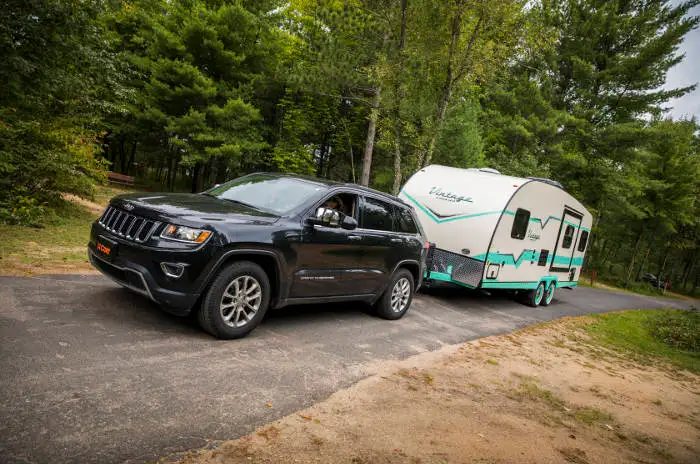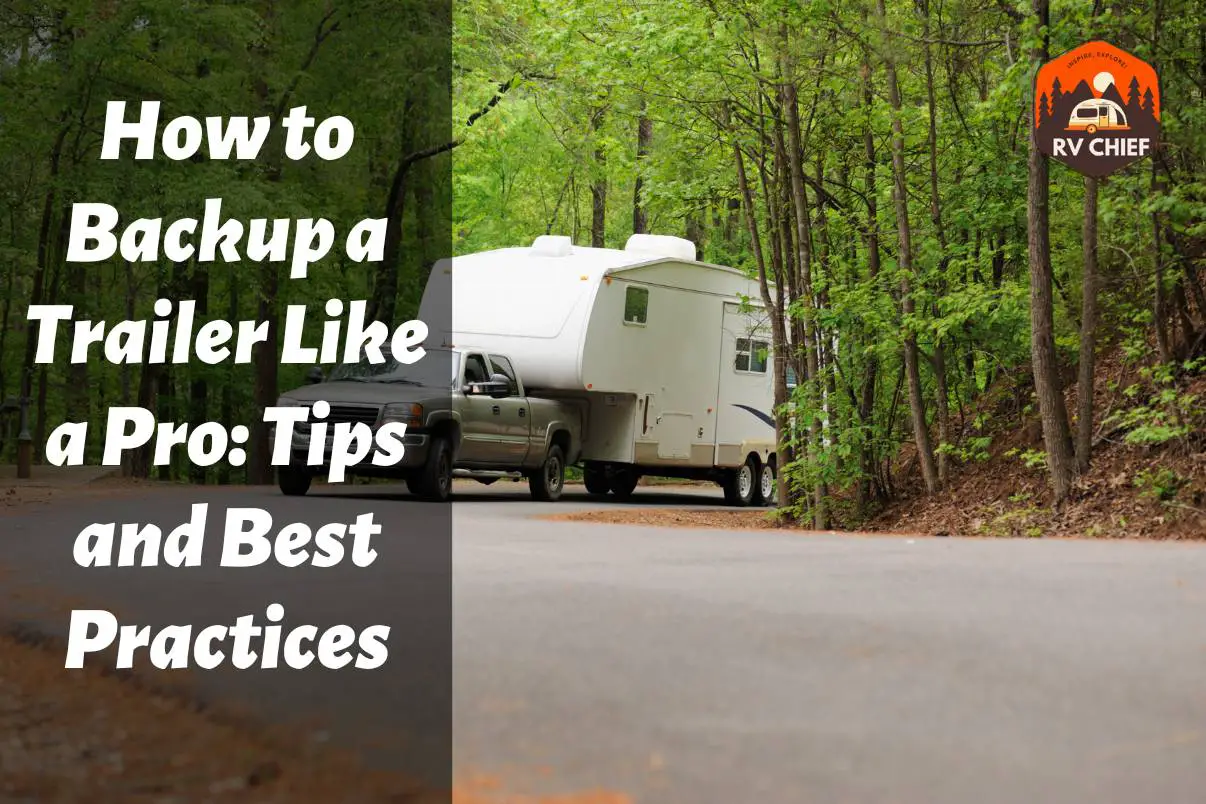Are you ready to master the art of backing up a trailer like a pro? Whether you’re a seasoned traveler or a newbie to the world of trailer towing, understanding the tips and best practices for trailer backup is essential.
Although, backing up a trailer can be nerve-wracking and quite tasking. Especially if you recently started driving, and it might take several attempts to master the art.
In this comprehensive guide, we’ll delve into the secrets of successfully maneuvering a trailer in reverse. From practical techniques and expert advice to step-by-step instructions, we’ll cover everything you need to know about backing up a trailer with confidence.
So, whether you’re looking for tips for backing up a trailer, guidance on how to reverse a trailer, or simply want to enhance your trailer backing skills, this guide is your ultimate resource. Get ready to transform into a trailer backup expert and conquer any parking lot or campsite with ease.
Table of Contents
- 1 What is Trailer Backup?
- 2 How Does Trailer Backup Work?
- 3 Understanding Different Types of Trailers and Their Backup Techniques
- 4 Essential Tips for Successful Trailer Backup
- 4.1 Adjusting the mirrors for optimal visibility
- 4.2 Communicating with a spotter or using backup cameras
- 4.3 Understanding the concept of steering in reverse
- 4.4 Maintaining patience and taking your time
- 4.5 Developing spatial awareness and anticipating the trailer’s movements
- 4.6 Utilizing reference points and visual cues to guide your backup
- 5 Backing up a Trailer into Different Scenarios
- 6 Advanced Techniques for Professional Trailer Backup
- 7 Troubleshooting Common Challenges
- 8 Conclusion
- 9 FAQs on How to Backup a Trailer Like a Pro
What is Trailer Backup?
Trailer backup is the process of reversing a vehicle while towing a trailer. It involves maneuvering the vehicle and trailer in reverse, typically in tight or confined spaces, such as parking lots, driveways, or campgrounds.
Additionally, trailer backup requires skill, coordination, and an understanding of the relationship between the vehicle and the trailer. It’s worth noting that backing up a trailer requires using the steering input, accelerator, and brake controls to effectively guide the trailer in the desired direction.
Furthermore, backing up a trailer is essential for tasks such as parking, docking, or navigating through challenging spaces. Various techniques, such as utilizing mirrors, visual aids, and proper steering methods, are employed to ensure safe and accurate trailer backing.
Ultimately, mastering trailer backup is important for RVers who frequently tow trailers or engage in activities that require precise handling of trailers in reverse.
How Does Trailer Backup Work?

Trailer backup involves a combination of careful steering, proper vehicle positioning, and a clear understanding of the trailer’s behavior. When reversing with a trailer, the key principle is to steer in the opposite direction that you want the trailer to move. For example, if you want the trailer to turn left, you should steer your vehicle to the right.
One important concept to grasp is that trailers pivot around a point known as the trailer hitch or coupling. This means that the trailer will move in the opposite direction of your steering input. It may take some practice to develop a feel for how the trailer responds to your steering actions.
Additionally, using your mirrors effectively is crucial. Adjust them to provide a clear view of the trailer’s position and be mindful of blind spots. Some drivers find it helpful to use visual aids, such as trailer backup cameras or alignment guides, to enhance their visibility and accuracy.
Overall, mastering trailer backup requires practice, patience, and an understanding of the relationship between your vehicle and the trailer. With time, you’ll gain confidence and become adept at maneuvering the trailer precisely where you want it to go.
Understanding Different Types of Trailers and Their Backup Techniques
Trailers come in various types, each requiring specific backup techniques. Whether it’s a fifth wheel trailer, airstreams, or utility trailer, mastering the appropriate steering, use of mirrors, and spatial awareness is key.
It can greatly enhance your ability to back up with precision and confidence. Below are some different types of trailers and their backup techniques.
Travel Trailers

These are the most popular non-motorized RV. They are easy to backup, and when in doubt, ensure you practice first.
Simply place some oranges on designated places in an open site and try backing up.
Also, make your mirror your friend. Instead of looking over your shoulder at every point, get a mirror and place it in a strategic position. This helps you have an overview of the back of the trailer, which further eases backing up.
Additionally, look out for when the travel trailer appears wholly in one part. Once this happens, steer the trailer toward the opposite side and have the trailer stays behind the towing vehicle.
If you can’t find a mirror, consider using a walkie-talkie or a camera. These help you get better at communicating with your partner and keeping you in check.
Fifth Wheel Trailers

Fifth wheels trailers are popular among full-time RVers and are best suited for stable and easier towing. When backing a fifth-wheel trailer, your direction depends on how well you control the steering wheel.
To backup your fifth-wheel trailer like a pro, place your hand firmly at the wheel and turn to the direction you want to back into. Slowly but steadily, drive towards the site and place the trailer into the entrance.
To back up straight, pull forward into the site, and your tires align straight, which is the best position for easy backing.
If you intend to back up to the left, you should get a partner. With a partner, ensure the back tires of your fifth-wheel trailer is some distance away from the top left side of the campsite.
At this point, you can start backing up till your car gets into a jacked position, and your trailer might get into a wide ‘v’ shape with your towing vehicle.
Simply steer back to the left and continue backing up. Also, let your partner notify you if the trailer gets too much into the left or right direction so you can easily adjust.
Pop-up Campers
Popularly known as Folding camping trailers, it appears more budget-friendly and one of the best options for families that would love to camp with small vehicles. Pop-up campers are easy to tow, as they are comfortably found behind typical family vehicles.
To back up a pop-up camper;
Firstly, you must understand that backing up is better done with a relaxed mind. So it would help if you tried not to feel frustrated. Instead, take a deep breath and take some rest before getting started.
Secondly, the shorter your pop-up camper, the easier it would be to back up. Therefore, you should make small movements on the steering and counter-steer once the trailer starts reacting to the steer.
If the trailer turns too sharply, slow down and counter-steer till it’s in the correct position. While backing into space, ensure you pull close to it and head back to the road once the pop-up camper’s front is in the middle.
By now, your trailer should be at a 45-degree angle to the site.
Furthermore, feel free to use a spotter or a mirror. Allow them to stand at a corner where they can easily view the rear of the trailer.
Teardrop Trailers

Before backing up your teardrop trailer, place your hand at the middle bottom of the steering wheel. This gives you control over the steering so you can quickly move in any direction, especially if you’re backing up a short trailer.
Next, learn the swoop method, which allows you to swoop to the campsite and pull out almost immediately to the opposite side of the lane. The teardrop trailer will get into a position where backing up is more straightforward.
As a newbie, your teardrop trailer is likely to jackknife. To correct that, simply pull forward and straighten the trailer in the right direction. Since you’re unsure of your backing skills, consider practicing in an open space and give it your best.
Toy Haulers
Toy haulers are relatively easy to handle, and if you’re just backing up for the first time, there are a few tips to follow.
Before you start, ensure there is enough space to back up. Inadequate space makes backing up difficult, as you will battle with both the space and the toy hauler.
To aid your backup, place a spotter and let them be on the lookout. The spotter is in charge of correcting your movements which helps you correct over-steering.
Also, ensure you have a good grip on the steering wheel. A good grip corrects jackknife under steering and helps you avert accidents on time.
Lastly, remove any object which might pose a hindrance on the road. This way, the road is safe and meat to back up.
Airstreams
Airstream trailers boast fantastic traveling experiences. It is well-known for its long-term performance and is relatively the most aerodynamically efficient trailer.
If you want to swiftly back up an airstream trailer, ensure your mirror is handy. With a good and clear mirror, you wouldn’t need to turn around.
Next, place your hand on the lower part of the steering wheel and start backing up. Once you turn the wheel to the left, the rear of the trailer moves in that direction.
If you are backing up left-wise, pull the car towards that direction and move straight ahead. Most preferably, try to back up into a spot at the driver’s side.
Essential Tips for Successful Trailer Backup
While backing up a trailer might seem to be a task, there are several ways to do it effectively. A few people might get the hang of it for the first few attempts, while others would have to try several times.
If you are in this category, you might wonder how to back up a trailer into a driveway.
Here are tips for backing up a trailer!
Adjusting the mirrors for optimal visibility
Relying on your mirror for guidance while backing up a trailer has proven to be effective. A well-positioned mirror helps you to monitor the trailer’s position.
Therefore, every trailer ought to have a clean and reliable mirror. If lacking, backing up a trailer might be more tasking.
- Position your mirror to give the best possible view
- Try to focus on the mirror for a better view
- The mirror helps you determine how much more you need to turn and to which side to turn to
Communicating with a spotter or using backup cameras
Alongside your back mirror, you might also need a spotter. A spotter helps to give a more balanced direction to your movement.
However, always ensure the spotter is reliable, and always check your back mirror to ensure accuracy. Most preferably, allow the spotter to stay behind the trailer and watch out.
Understanding the concept of steering in reverse
Steering a trailer requires precaution, especially in tight places. If you are wondering how to back up a trailer in a tight place, you should first understand the concept of steering during a reverse.
Directly controlling your trailer’s movement is vital to navigate confined areas successfully.
- Always place your hand at the bottom of the wheel of the trailer
- To move the trailer to the left, turn your hand to the left and vice versa
- Gently turn the steering to the desired direction
Maintaining patience and taking your time
No doubt, backing up a trailer can be a bit frustrating, especially if you are a beginner. It can stretch you to the limit where you feel like giving up.
However, it’s always important to maintain patience. It might not move exactly how you designed it, but getting frustrated won’t solve it either. Also, try to back your trailer up again, even if the first attempt failed.
Developing spatial awareness and anticipating the trailer’s movements
Always try to anticipate the movement of the trailer while steering. Unlike prose, an inexperienced driver tends to turn too little.
A wide U-turn is usually better than turning a little because it helps your car and trailer to make a right turn. However, try not to exaggerate while turning to avoid your trailer jackknifing.
Utilizing reference points and visual cues to guide your backup
Mirrors are pretty reliable, and so is selecting a reference point. The car, RV, or surroundings can be reference points backed up by visual clues to help you navigate the steering process.
With an accurate visual cue, ensure these reference points are lined up in the back mirror as you make a reverse turn.
Backing up a Trailer into Different Scenarios
It’s one thing to back up a trailer in a driveway, and it’s another to do the same at a 90-degree angle. If you want to know how to back up a trailer like a pro, you must learn to do so in different scenarios.
As tasking as it may appear, it’s the best way to navigate in any direction. It will further enhance your driving skill and push you to overcome all hurdles when next you go camping.
How to backup a trailer into a driveway
Driveways are usually tight and require special skills to steer into. Firstly, check out for obstructions like tree branches and remove them from the driveway. This helps to avoid hazards while maneuvering into the driveway.
Also, you can use a marker to checkmate how far you can go. Often, a marker can be a rock placed at a position you wouldn’t want to go beyond. This helps to checkmate your steering and not pass boundaries.
Lastly, try to position your right hand below the steering, as this gives a better grip. Now, you can start steering in the desired direction.
More importantly, remember that moving your hand to the right moves the steering wheel to the left side.
How to backup a trailer at a 90-degree angle
Before backing a trailer at a 90-degree angle, always ensure you can back it up forward first.
Here are the steps to follow;
- Choose a parking space by your right
- Start by using your hand or turn signals to indicate your intention of backing into the space.
- Move forward a little past your chosen parking space. Ensure the line of the following parking space lines up with your side mirror.
- Check out for traffic and ensure the road is free.
- Steer to the left and continue driving until the trailer is 45 degrees to the parking lot.
- Try to visualize the left and right corners of the trailer from the mirror.
- Check out for pedestrians and put the trailer on reverse if none is found.
- Once the trailer’s rear gets close to the center of the parking space, firmly turn to the right and drive straight.
How to backup a trailer into a tight space
Perhaps you can backup a trailer into a driveway, but what about other tight spaces? It takes skill and practice to back up, especially in a tight space quickly.
As daunting as it may look, backing up a trailer into tight places is easy with the proper steps.
- Use an extended side mirror
- Get a spotter to be on the lookout
- Get a backup camera for better visuals
- Adjust the trailer and position it appropriately
- Steer slowly
- Practice more
Advanced Techniques for Professional Trailer Backup
No doubt, backing up a trailer like a pro is quite tricky. This is because the trailer isn’t attached to the car. Asides from the methods mentioned above, below are some advanced essential techniques for professional trailer backup you must know.
Mastering straight-line backup with precision
Straight-line backing is the most accessible type of backup and, as such, the most common trailer backup. If you are just starting as a professional driver, straight-line backup is the first you will learn.
This type of backup occurs in straight driveways and would not require much steering. However, there might be more curved driveways than there are straight lines.
In other words, backing up a trailer in a straight line is critical to learning how to back up in curve driveways.
Here’s how to achieve the most effortless backup process;
- Place the vehicle properly; let it line up as straight as possible
- Start backing
- Move slowly
- Maintain a straight position
- Use the side mirrors
- If the trailer overshadows a part of the mirror, you are on the wrong path
- Gently steer to maintain an even position
- Feel free to adjust or start again if you enter the wrong position
Understanding the challenges of reversing with surge brakes
Surge brakes are both easy and versatile to use as it improves your trailer’s braking system, which ensures safety. However, it makes reversing more tasking, especially when backing up a trailer.
There are two types of surge brakes; disc and drum brakes. Without a 5th pin, the trailer automatically slows down whenever you are in reverse.
This is because it would think you want to slow down when all you intend to do is reverse.
At this point, the sliding pin through the tongue moves rearward. To prevent this, you would have to put the steel key into its path.
Tips for backing up a trailer using only mirrors
Over time, backing up a trailer with mirrors has proven effective. As a newbie, you might struggle to back up with a mirror.
However, if you want to know how to back up a trailer like a pro, then you would need to master how to use your mirrors.
Firstly, remember that you wouldn’t need to keep craning your neck backward. The side mirrors are there to do their job, so you just rely on them.
Now re-adjust your side mirrors to see the back of the vehicle and the side of the trailer. Try to clean up the mirror to ensure it doesn’t give a blurred view.
Next, if you see the trailer more in the left mirror, you should steer to the left. This way, your trailer will go behind the car and straighten up.
Always focus on the mirrors, as they are the only guide you need. If needed, make adjustments where possible, always to keep both the car and trailer on track.
Pro tip
Troubleshooting Common Challenges
Getting used to backing up a trailer will come with numerous challenges. However, your attitude towards each challenge and how best you tackle them determines how fast you learn.
Correcting oversteering and jackknifing
Closely related to understeer, oversteering occurs whenever the vehicle’s rear tires reach their adhesion limit while steering at a corner.
The braking system, cornering speed, and throttle play significant roles during oversteering. To prevent or correct oversteering;
- Don’t enter the corner at a high speed
- Don’t accelerate into a bend or corner too early or with force
- Don’t lift the throttle at mid-corner
On the other hand, jackknifing is when the towing car skids causing the trailer to keep pushing from behind. Most times, jackknifing occurs if the vehicle is carrying a light load behind, as this causes the weight to be unevenly distributed.
- Firstly, avoid carrying light loads behind the vehicle.
- Avoid skidding
- Gradually reduce your speed when braking and spread the braking over a long distance.
- Try not to accelerate or decelerate on a bend
- Dont brake and swerve at the same time
Dealing with limited visibility and blind spots
A blind spot is a zone outside a driver’s area of vision. They are inevitable and something to always look out for. Once you can smoothly navigate your steering wheel and avoid blind spots, you are one step ahead of becoming a pro.
If you experience limited visibility while backing up a trailer, do this;
- Adjust your side mirrors
- If possible, look over your shoulders to get a clearer view
- Use the vehicle’s turn indicator
Recovering from mistakes and adjusting the trailer’s position
Although facing challenges might be unavoidable, taking immediate action is essential. One sure way of achieving that is to recover from your mistakes and adjust the trailer’s position.
Perhaps you oversteered, and the trailer is moving out of the train. Consider it a mistake and quickly swerve the trailer back into the road. If possible, apply brakes where needed and ensure your vehicle and trailer move in the right direction.
Conclusion
Camping is much better if you can comfortably back up your RV trailer like a pro. Whether you find it difficult to back up in a tight place, at a 90-degree angle, or into a driveway, you can follow the steps outlined above.
Always try to understand the concept of steering in reverse and master straight-line backup with precision. Also, the importance of side mirrors cannot be overemphasized, as they can make or mar your backup. Good side mirrors provide the best view and allow you to back up quickly.
Above all, patience and persistence are needed to master this skill. It may take days or weeks, but strictly adhering to the tips here will make you a pro at backing up a trailer.
FAQs on How to Backup a Trailer Like a Pro
What is the best way to back up a trailer?
The best way to back up a trailer is to start by practicing in an open space. Use your mirrors to guide your movements, and take it slow. Make small adjustments and use the opposite steering technique—turning right to make the trailer go left and vice versa. Patience and practice are key!
Which side is easier to back up a trailer from?
Backing up a trailer can be subjective, but for most drivers, backing up from the driver’s side (left side in countries with left-hand traffic) tends to be easier. This is because you have a better view of the trailer and surrounding obstacles from the driver’s seat.
However, it ultimately depends on your personal comfort and experience. Additionally, it’s important to practice and become comfortable with both sides to handle different parking scenarios effectively.
Can I hook my trailer at an angle?
Yes, you can hook your trailer at an angle, but it’s important to exercise caution. Align the trailer and tow vehicle as straight as possible for better stability. If you need to hook it at an angle, make sure to account for any potential stress on the hitch and ensure a secure connection.


